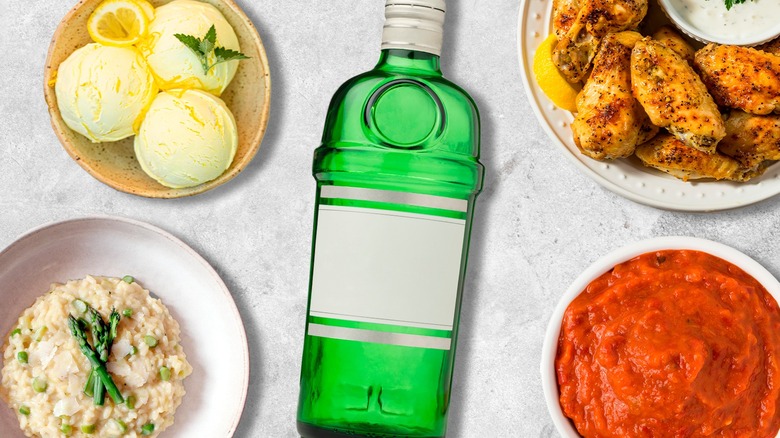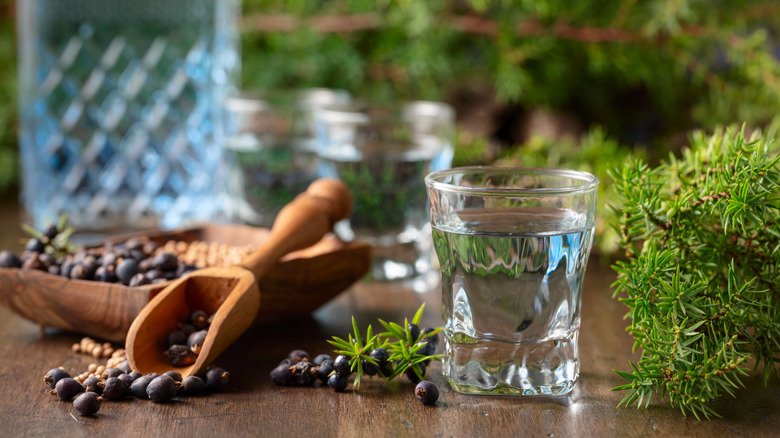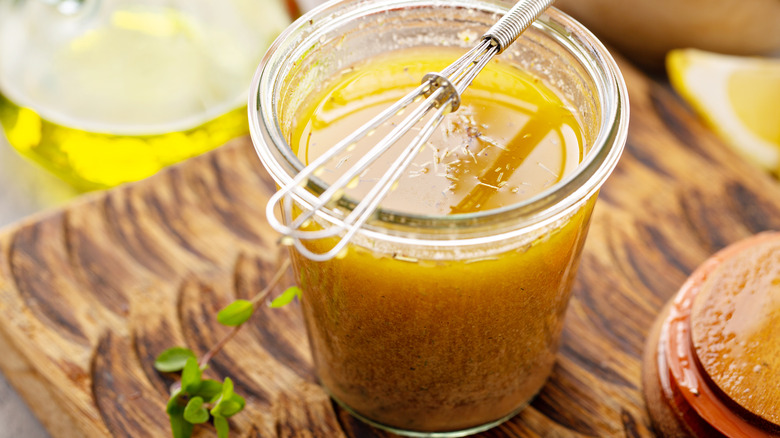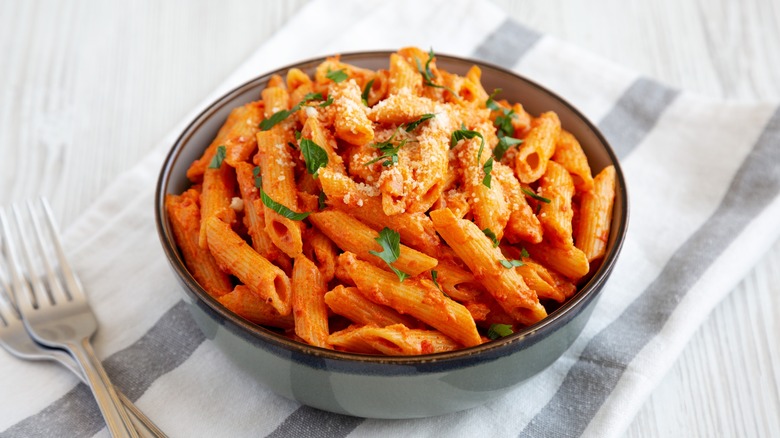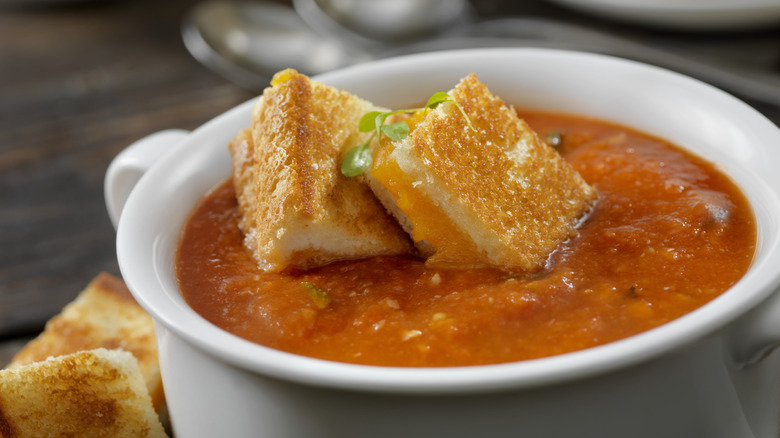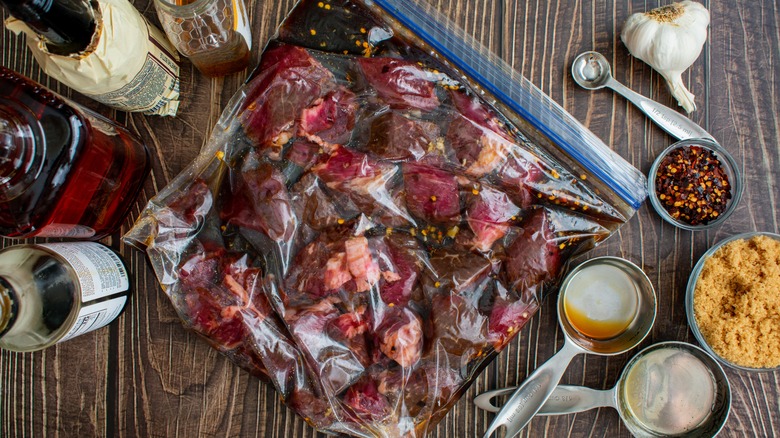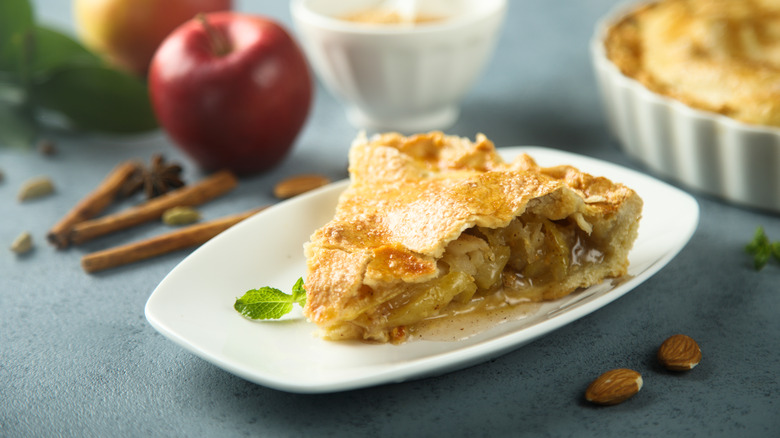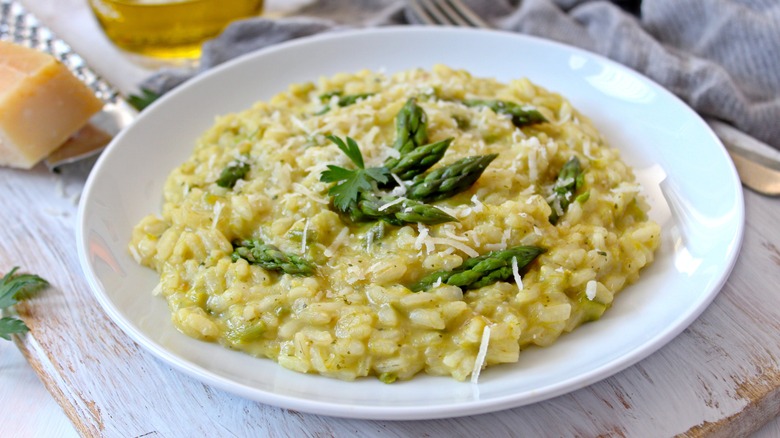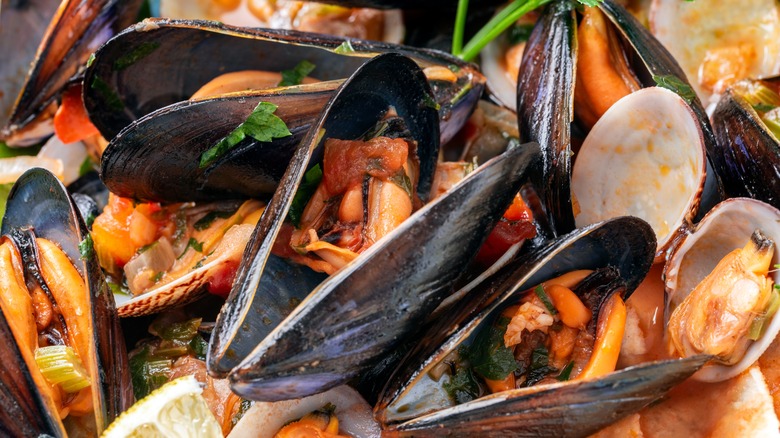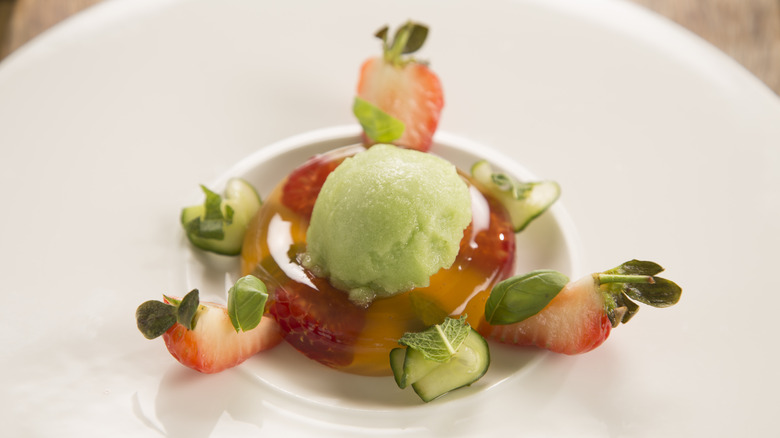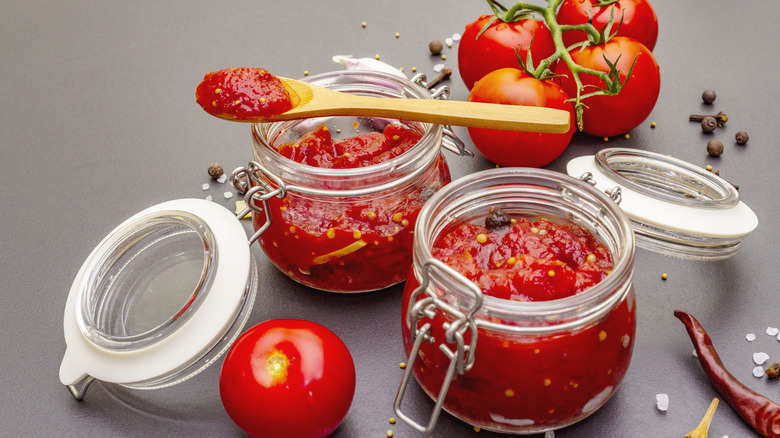12 Creative Ways To Cook With Gin Like A Trained Chef
If you want to use wine in your cooking, you'll find lots of advice online. Gin? Not so much. That's largely because of gin's distinctive flavor profile, which is great in cocktails but a complication in cooking. It works best in situations where its flavor can make a contribution to the finished dish.
I'm a trained chef and former restaurateur, and I've used gin and other spirits a lot in both my home and professional cooking. It's a fun ingredient to play with, and the rise of artisanal gin-making means you can choose between some very distinctive and nuanced flavor profiles.
I do have two cautions to offer, right from the start. The first is that you shouldn't use too much gin; it's not as forgiving as wine. The second is that before serving a gin-infused dish to guests, you should always check whether they need to avoid alcohol for religious reasons, or because they're in recovery. There's a persistent myth that alcohol cooks out, but that's only partially true. So experiment and have fun, but "cook responsibly."
1. Substitute gin when your recipe calls for juniper berries
Novice cooks typically start off by learning simple and familiar recipes. That's a good way to build confidence, but eventually, most of us spread our wings and try new things. That's when you start running into offbeat ingredients you might not have in your pantry, like juniper berries.
Juniper berries have a sharp, pine-like flavor that's classically paired with meats like venison or duck, but shows up in other dishes as well (even chili can be elevated with juniper berries). They also happen to be the traditional main flavoring element in gin. You may not have juniper berries in your pantry, and supermarkets don't often stock them, but it's easy to get your hands on some gin.
Gin, then, is a go-to substitute for juniper berries when you want that flavor but can't justify splashing out for a specialty ingredient you may not use very often. You'll usually get your strongest juniper flavor if you choose a bottle labeled "Dry Gin" or "London Dry Gin," which are typically juniper-forward. Use just a tablespoon or two in quick-cooking recipes. In long-cooking recipes, you can have a heavier hand because more of the alcohol will cook out as it simmers.
2. Make a ginaigrette for your salads
Gin's characteristic mixture of herbs and spices (usually referred to collectively as "botanicals") gives it a nuanced and complex flavor. That's why gin is perfect in so many cocktails. With other spirits, bartenders add a dash or two of bitters to create a similar effect.
Bitters are useful in cooking as well, and like other chefs, I've used them to make the flavors of my sauces and dressings more complex. The same holds true for gin, though it's less concentrated. One of my favorite ways to use it is in a salad dressing, or "ginaigrette." Just a spoonful or two of strongly-flavored gin in a batch of vinaigrette will give the dressing complex notes to complement your salads.
I like a classic dry gin in salads with mild greens, where its botanicals will stand out. With bitter greens like escarole or radicchio, I'll switch to a citrus-forward gin that brings sweetness and fruitiness to balance the assertive greens. Don't be afraid to experiment: Scottish chef William Hamer uses a gin vinaigrette on a salad of charred samphire, a wild green harvested at the seashore.
3. Upgrade your vodka tomato sauce
Tomato sauce with vodka is an Italian-American classic, and the alcohol plays an important role in the sauce. Many flavor molecules are highly soluble in alcohol — which is why it's used as the base in commercial flavor extracts — so that splash of vodka actually helps pull flavors into the sauce. It also helps the other ingredients come together, emulsifying the sauce to make it smoother.
Swapping the vodka for gin is an easy way to upgrade your sauce. Plain vodka has no taste by design, while gin is full of flavor. Better yet, gin's botanicals play really nicely with tomatoes. The juniper flavor in a classic gin isn't exactly a ringer for the herb rosemary, but their vegetal, pine-like notes are pretty similar. It's not the most obvious connection until you actually taste that first mouthful, but when you do it'll make perfect sense.
Once you've wrapped your head around the basic idea, you can push it even further. Consider TikTok's dirty martini pasta dish that turns the classic cocktail into dinner. It doubles down by adding olives and lemon zest to the basic pasta recipe, just as the classic cocktail does. It's a great dish for entertaining, and will definitely get your guests talking.
4. Make gin and tomato soup
The affinity between gin and tomatoes is well established, and it's not limited to pasta dishes or cocktails. It also makes for a really good tomato soup.
Ideally, you'd make your tomato and gin soup from fresh, ripe garden tomatoes, or at least peak-season tomatoes from a local farmer's market. The sweetness of really ripe tomatoes makes this soup sing, though you can add a smidge of sugar if your tomatoes aren't quite all they should be. It's a perfect summer soup, and it comes together in just a few minutes on the stovetop. Peeling your tomatoes first adds a step, but the finished soup will feel much more refined if you choose to take the extra few minutes.
I live in an area where the garden season is short, and perfectly ripe tomatoes are correspondingly rare, so I have a "cheat" version. I use crushed canned tomatoes instead because they're usually processed at peak ripeness. Two parts tomato to one part heavy cream is a good starting point, but I've used equal parts cream and tomato if I'm serving it in small bowls as a starter. Either way, gin adds flavor and also helps emulsify the cream and tomato, as it does in pasta sauce.
5. Marinate meat, poultry, or seafood
One of the classic methods for adding flavor to meat is through a marinade, which typically combines an acidic ingredient, flavorings, and some form of oil. Wine is often used both as an acidic ingredient and a flavoring, but less common marinades may include plain yogurt, miso, and spirits (including gin).
Gin is especially good with red meats, from beef and venison to lamb and goat. Juniper berries are a common flavoring in recipes with venison in particular, and gin's juniper flavor is one way to continue that classic pairing. You aren't restricted to those meats, though. Gins come in many flavor profiles other than the classic juniper-forward version, and you'll find many that play nicely with poultry or even fish (citrus flavors are your best bet with seafood).
You can also turn to your nearest cocktail lounge (or mixology guidebook) for inspiration. The flavor profiles of cocktails can make for interesting marinades as well, especially if the cocktail is one of your special favorites. If you love a Negroni, for example, you might use it as a marinade for unconventional (but delicious) pork shoulder tacos.
6. Make your pie crust flakier
I've focused a lot on the flavor of gin, and how it complements the flavors in the foods you choose to cook with it. Gin's alcohol content is usually an afterthought, except in terms of how long you need to cook a given dish.
Sometimes, though, the alcohol is entirely the point. Have you ever seen a pastry chef on TV or in a cookbook explaining that vodka can help make a perfect pie crust? The logic is simple: You need to moisten the crust's ingredients to make a workable dough, but water develops the flour's gluten and makes your crust tougher. Alcohol doesn't have the same effect, so replacing some of the recipe's water with booze lets you have it both ways.
Vodka is the go-to, in this case, because it's inexpensive and flavorless, but there's no reason you can't use gin instead if that's what you have on hand. In this instance, the gin's flavor is unlikely to be a factor in the finished pie. You won't be using a lot of it to begin with, and the ratio of crust to filling is low enough that any residual gin flavor will be undetectable.
7. Enhance your favorite desserts and baked goods
Gin comes in a lot of different flavor profiles. Mainstream distilleries have broadened their mass-market products in recent years, in response to the success of flavored vodkas (ride that bandwagon!) You'll also find plenty of artisanal gins from independent distillers or as limited-time offers from the big companies. Each of them will have a distinctive flavor profile, as distillers try to set themselves apart from their competitors through unique combinations of herbs and spices.
One thing that all of these gins have in common is their potential to upgrade your baked goods. Gins with strong-flavored botanicals, like the classic dry gins, can offer an appealing savory note to complement the sweetness of your favorite cake or cookie (like adding rosemary to shortbread, or lavender to sugar cookies). In recipes that already skew toward the savory, like these parmesan and parsley biscuits, gin is a way to double down on that note.
A whole other style of gin leans toward fruity flavors, most notably citrus (though classic sloe gin is making a comeback as well). Fruit-forward gins are a slam-dunk addition to cakes, puddings, and cheesecakes as an ingredient, and they also work well in sauces, custards, and as a flavoring in icing.
8. Try gin and lemon chicken wings at your next barbecue
What's your favorite thing to prepare when you're expecting company? Some of us lean toward simple things like nachos, or a cheesy crab dip, while others favor something a bit more substantial like ribs or wings.
If you're already in the "something more substantial" camp, how about gin and lemon wings? They're a fun change from the usual suspects, like Buffalo wings or honey-garlic wings (wonderful though both are) that turn up at every party. These wings get a marinade of gin, lemon juice, and brown sugar, with the sugar balancing out the tart lemon juice. It also helps provide browning and caramelization as the wings cook.
This recipe calls for baking the wings on a sheet pan in a hot oven, which is a year-round option, but they can also be grilled if you prefer. You'll have to keep a close eye on them to keep them from burning (because of the sugar content) but they're well worth the effort and will definitely liven up your next block party.
9. Cooking risotto? Add gin instead of wine
If you've ever cooked risotto, you'll know that it's an exception to the rule about rinsing rice before you cook it. Rices like arborio and carnaroli contain extra starch, which releases into the cooking liquid and thickens your finished risotto.
That cooking liquid often begins with a splash of wine added to the pan. It's mostly allowed to cook off, though the rice will absorb some of the wine's flavor and retain it after broth is added to finish cooking the dish. If you want to change things up, gin may be the best wine substitute for risotto.
Think about it: Which other spirit gives you such a complex and nuanced set of flavors to play with, or such a range of flavor profiles? The strong herbal notes of a classic gin work with almost any risotto that leans into vegetables or herbs as a flavoring, as well as poultry and meats. Citrus-forward gin can play the same role in any risotto containing poultry or seafood. Citrusy gin also makes a great addition to risotto that will be served with rich braised meats, like osso buco, because it will cut the meat's richness (and it'll complement the lemon notes in a gremolata garnish, as well).
10. Brighten your favorite seafood recipe
One of my former employers used to participate in a lot of trade shows, where we'd make showy seafood dishes (usually mussels or clams) flambéed with gin or Pernod. It was always a show-stopper, and we took advantage of the high ceilings in conference centers to use a bit more alcohol than strictly necessary so we'd get an extra-large plume of flame (don't do that at home!)
The key point in that anecdote isn't that flambéing seafood is fun and showy (though it is), but that the herbal notes in gin and the anise of Pernod go really well with seafood, specifically shellfish. So the next time you're planning a meal around mussels, clams, shrimp, or even snails, consider hitting them up with a generous splash of gin (because everybody's already had the usual escargot with garlic, right?)
You won't find a lot of seafood recipes out there that explicitly call for gin, but that's okay. There are plenty that call for Pernod, absinthe, or ouzo, all of which are anise-flavored, and a juniper-forward dry gin is a great substitute or variation on the theme. If you want an example to start with, try this drunken shrimp recipe and swap out the (relatively) hard-to-find absinthe for your favorite gin.
11. Enjoy soft, scoopable sorbets
Frozen desserts have typically been a thing people buy, as opposed to making at home, but that's changed in recent years. For one thing, there are lots of good ice cream machines out there now, and recipes for them are all over social media. The unconventional Ninja Creami ice cream maker, in particular, has drawn a lot of eyeballs on TikTok.
Once you've gotten the frozen desserts down, the next big step is graduating to sorbets. They're trickier because they're mostly fruit-based and have a tendency to freeze as hard as a rock. Ingredients like sugar and alcohol can help keep your sorbets soft and scoopable — sugar because of how it reacts chemically with liquids and alcohol because it's a natural antifreeze. So this is where gin comes into the picture.
Recipes like this boozy lemon sorbet often call for vodka, because it's a flavor-neutral ingredient. Gin gives you the same softening effect, but it's also a flavoring ingredient that you can play with (because neutrality is overrated). The classic juniper flavor of dry gin plays well with fruit, and so do citrusy offerings like Tanqueray's Flor de Sevilla. You also have the option of savory-leaning sorbets (because alcohol lets you use less sugar), where unconventional flavors (like Hendricks' cucumber and rosewater notes) can be interesting.
12. Upgrade your tomato jam for a memorable condiment
Growing more experienced and capable as a cook means you can stretch your wings and try different and interesting things. After you've mastered basic pickles and relish, for example, you might want to take a shot at making your own condiments.
Often those condiments are thick and flavorful alternatives to the usual ketchup, mustard, and relish. Tomato jam is a perfect example. It's made by cooking down fresh or canned tomatoes with a variety of flavoring ingredients until they're thick and spreadable. It's also another instance where gin's affinity for tomatoes can really shine. Just add a healthy splash of gin to your favorite tomato jam recipe, and let it cook down along with everything else. Its herbal notes will complement and elevate the other flavors, making a good thing even better.
You can find tomato jam recipes on various sites and in various cookbooks, either as a standalone large-batch recipe or as one element in another recipe. In this meat loaf sandwich recipe, for example, the tomato jam and aioli are used as condiments and flavorings to turn an already-good meat loaf into a genuinely stellar sandwich.
